Are you looking to add a touch of elegance and vibrancy to your garden? Purple perennial flowers might be just what you need. With their rich hues and lasting beauty, these flowers can transform any garden space into a captivating, lively sanctuary. From deep, royal purples to soft, lavender shades, purple perennials offer a variety of options to suit every garden style and preference. Not only do they provide year-round charm, but they also attract pollinators like butterflies and bees, enhancing the ecological balance of your garden. In this blog, we’ll explore nine stunning purple perennial flowers that will make your garden come alive, offering you a perfect blend of beauty and resilience.
1. Delphiniums
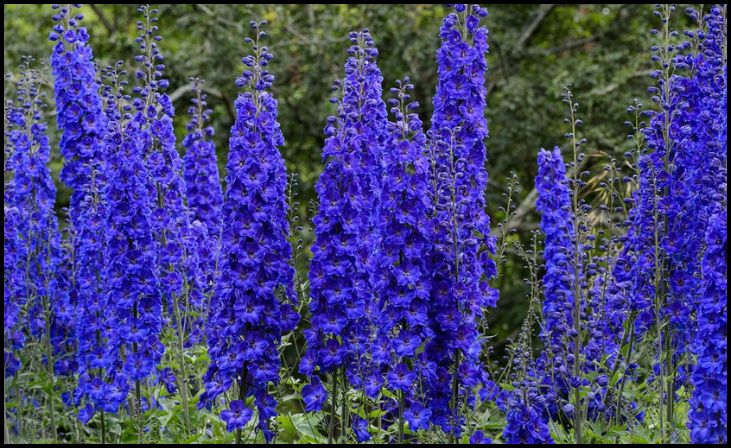
Delphiniums are a striking addition to any garden with their towering columns of purple blooms that attract butterflies and bees, making them ideal for cottage gardens. These perennials stand tall, often reaching heights of 3 to 6 feet, creating a stunning vertical accent in flower beds and borders. Delphiniums thrive in full to partial sun and well-drained soil. For optimal growth, plant them in a location that receives morning sunlight and afternoon shade, particularly in hotter climates. They prefer cooler temperatures and benefit from regular watering, especially during dry spells. To support their tall, heavy flower spikes, staking may be necessary. Delphiniums come in various shades of blue, purple, pink, and white, adding vibrant colors and a touch of elegance to any garden setting.
2. Hyacinths
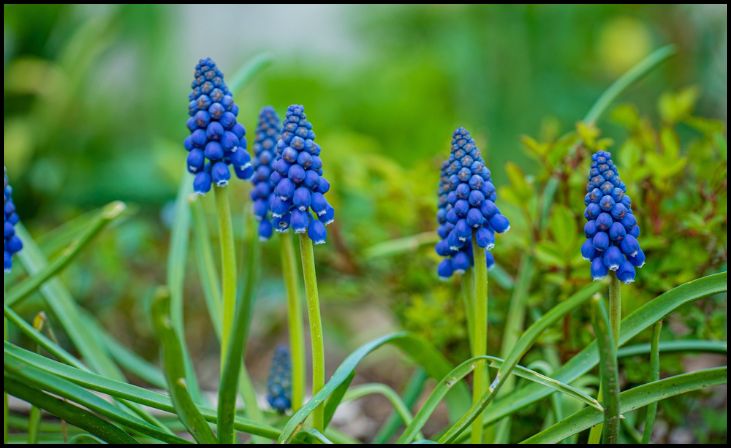
Hyacinths are known for their fragrant, bell-shaped flowers that bloom in spring, making them a perfect choice for Southern gardens. These bulbs produce dense clusters of flowers in a wide range of colors, including blue, pink, purple, red, white, and yellow. Hyacinths require a period of cold temperatures to bloom successfully, making them well-suited for USDA Zones 4-8. Plant the bulbs in the fall, about 6-8 weeks before the first expected frost, to ensure they establish roots before winter. Hyacinths thrive in well-drained soil and full sun to partial shade. When planting, place the bulbs 4-6 inches deep and space them about 3-4 inches apart. Water the bulbs thoroughly after planting, and then sparingly during the winter months. As they bloom in the spring, their sweet fragrance will fill the air, providing a delightful sensory experience.
3. Sweet Peas
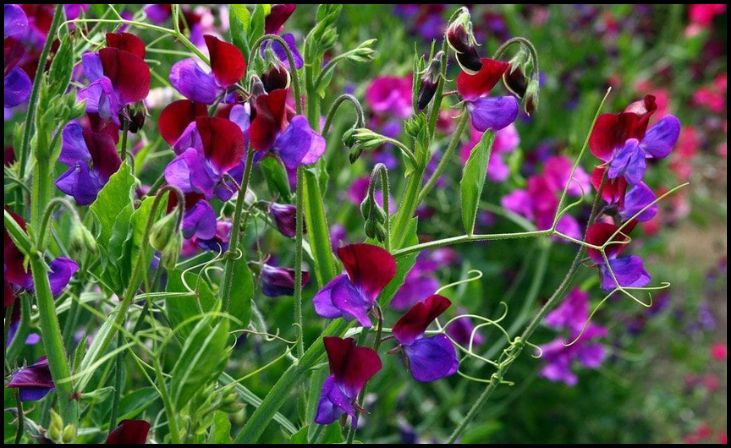
Sweet peas are a cottage garden essential with brightly colored blooms on tall, elegant stems. These annual climbers are known for their intense fragrance and a wide range of colors, from pastels to vibrant hues. Sweet peas thrive in rich, well-drained soil and full sun. In mild climates, plant them in the fall to enjoy early spring blooms. In cooler areas, wait until after the last frost to plant. For best results, soak the seeds overnight before planting to soften their hard coats and encourage germination. Plant the seeds about 1 inch deep and 2-3 inches apart. Provide a trellis or support for the vines to climb as they grow. Regular deadheading of spent flowers will promote continuous blooming. Sweet peas are not only beautiful but also excellent for cutting, allowing you to bring their delightful scent indoors.
4. Fan Flowers
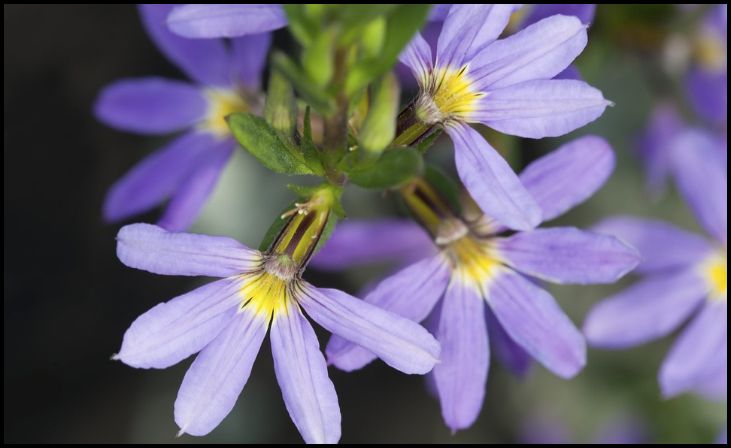
Fan flowers, also known as Scaevola, are vibrant outdoor container fillers with unique fan-shaped blooms. These low-growing, trailing plants are perfect for hanging baskets, window boxes, and garden beds. They love full sun and thrive in summer heat, making them an excellent choice for warm climates. Fan flowers are grown as annuals outside of Zones 10 and 11 but can be overwintered indoors in cooler regions. Plant them in well-drained soil and ensure they receive plenty of sunlight. Water regularly, especially during dry periods, but avoid waterlogging. Fan flowers are drought-tolerant once established and require minimal maintenance. Their continuous blooming from spring to fall provides long-lasting color in the garden. Available in shades of blue, purple, white, and pink, fan flowers add a splash of color and a touch of whimsy to any outdoor space.
5. Summer Phlox

Summer phlox (Phlox paniculata) are hardy perennials that attract butterflies and hummingbirds with their lush, vibrant colors. These plants are known for their large, fragrant flower clusters that bloom in mid to late summer. Summer phlox thrive in USDA Zones 4-8 and require good air circulation to prevent powdery mildew. Choose mildew-resistant varieties to minimize the risk of disease. Plant them in a location that receives full sun to partial shade and has well-drained soil. Space the plants about 18-24 inches apart to allow for proper air circulation. Water regularly to keep the soil consistently moist but not soggy. Deadheading spent blooms will encourage new flower production and extend the blooming season. Summer phlox are ideal for mixed borders, cottage gardens, and as cut flowers, adding height, color, and fragrance to the landscape.
6. Anemones

Anemones, often referred to as windflowers, are charming perennials available in various shapes and sizes. They are known for their delicate, poppy-like blooms that sway gracefully in the breeze. Anemones are ideal for mass planting in borders, rock gardens, and woodland settings. They are also popular as cut flowers due to their long-lasting blooms. Plant anemones in the fall for early spring blooms. Choose a location with well-drained soil and partial shade to full sun. Soak the corms in water for a few hours before planting to help them establish roots quickly. Plant them about 2-3 inches deep and 4-6 inches apart. Anemones are relatively low-maintenance and can naturalize over time, creating a beautiful carpet of flowers. Available in colors such as white, pink, red, blue, and purple, anemones add a splash of color and elegance to any garden.
7. Clematis

Clematis are climbing vines that add a spectacular floral display to higher garden areas. Varieties such as ‘Jackmanii’ are known for their large, showy flowers that bloom in late spring or early summer. Clematis vines can reach heights of 10-12 feet, making them perfect for trellises, arbors, and fences. They thrive in full sun to partial shade and well-drained soil. To encourage healthy growth, keep the roots cool and shaded while ensuring the vines receive plenty of sunlight. Mulching around the base of the plant can help retain moisture and regulate soil temperature. Clematis require regular watering, especially during dry periods, and benefit from monthly fertilization during the growing season. Pruning is essential to maintain their shape and promote vigorous blooming. Clematis come in a wide range of colors, including purple, blue, pink, red, and white, adding vertical interest and stunning beauty to any garden.
8. American Wisteria
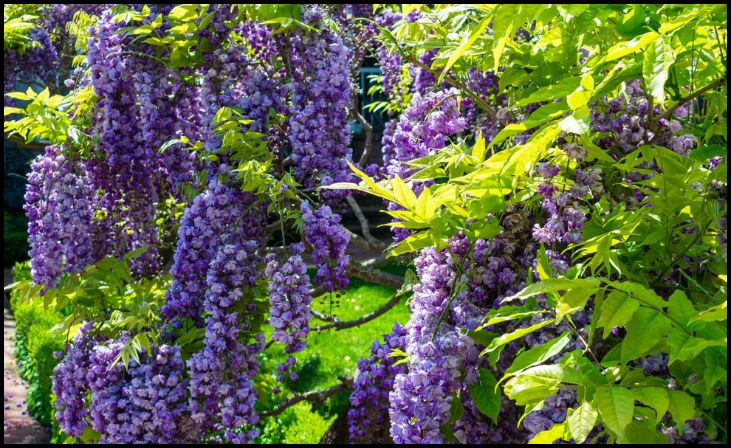
American wisteria, including varieties like Kentucky wisteria, is a stunning vine that produces cascading clusters of fragrant flowers. These vigorous climbers are perfect for pergolas, trellises, and arbors, creating a dramatic floral display. American wisteria blooms in full sun and well-drained soil, thriving best in USDA Zones 5-9. Annual pruning is essential to control their growth and encourage prolific blooming. Prune after flowering to shape the vine and remove any unwanted shoots. Water regularly to keep the soil moist but not waterlogged. American wisteria is less aggressive than its Asian counterparts, making it a more manageable choice for home gardens. The beautiful flowers, which range in color from blue to purple, attract pollinators such as bees and butterflies, adding life and movement to the garden.
9. Little Girl Magnolias
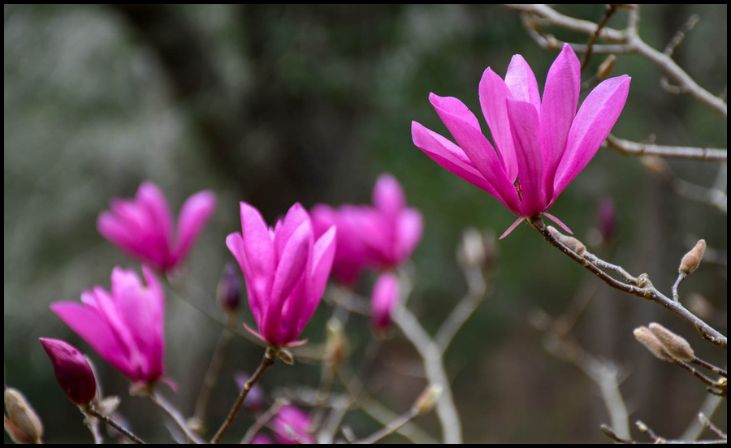
Little Girl Magnolias are compact magnolia trees that are perfect for smaller garden spaces. These hybrids, including varieties like ‘Ann’ and ‘Jane’, are known for their later blooming and dense growth. They produce large, tulip-shaped flowers in shades of pink, purple, and white. Little Girl Magnolias thrive in full to partial sun and loamy, moist soil. They are well-suited for USDA Zones 4-8 and can reach heights of 8-15 feet, making them ideal for smaller landscapes. Plant them in a location with good air circulation and provide regular watering, especially during dry spells. Mulch around the base of the tree to retain moisture and suppress weeds. Little Girl Magnolias are relatively low-maintenance and resistant to many pests and diseases. Their stunning blooms and compact size make them an excellent choice for adding beauty and elegance to any garden setting.

